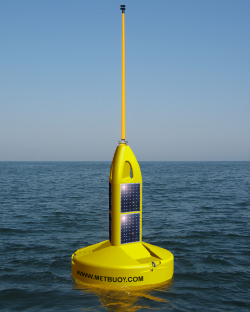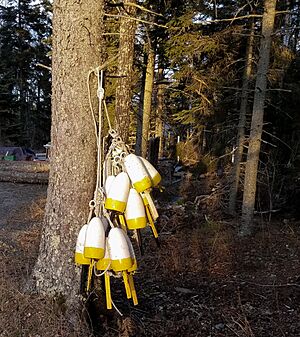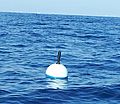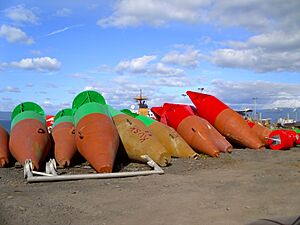Buoy facts for kids
A buoy is a floating object or marker placed in the sea. Buoys have many different jobs. Some stay in one spot (anchored), while others are allowed to float freely.
One important job of buoys is to help keep people safe. For example, buoys can mark the end of a safe swimming area. If swimmers go past these buoys, strong currents might pull them out to sea.
Contents
What Are the Different Kinds of Buoys?
Buoys come in many shapes and sizes, each designed for a special purpose. Here are some of the main types:
- Sea mark: These buoys help boats and ships navigate safely. They mark channels, dangers, or special areas. Some even have bells or gongs that ring when waves move them!
- Lifebuoy: This is a life-saving buoy. It's designed to be thrown to someone in the water to help them float. It usually has a rope so the person can be pulled back to safety.
- Safe water mark: Also called a Fairway Buoy, this buoy shows the entrance to a channel or where land is nearby.
- Emergency Wreck Buoys: These buoys quickly mark new shipwrecks to warn other ships. They are striped blue and yellow and have a flashing blue and yellow light. They are used for a short time, usually 24 to 72 hours, after a wreck happens.
- Wreck buoy: This buoy marks a wrecked ship to warn other vessels to stay away from hidden dangers.
- Mooring buoys: These buoys float on the water's surface and are used by ships or boats to tie onto, keeping them in place.
- Tripping buoys: If a boat's anchor gets stuck, a tripping buoy helps to free it. It keeps one end of a special 'tripping line' on the surface.
- Surface marker buoy: Scuba divers take these on dives to show their position underwater.
- Decompression buoy: Submerged scuba divers use these to mark their spot underwater while they are doing decompression stops (pauses to safely return to the surface).
- Shot buoy: This buoy marks dive sites for safety boats. It helps divers go down to the site more easily, especially when it's hard to see or there are strong currents. It also helps them safely do decompression stops on their way up.
Buoys for Special Uses
- Submarine communication buoys: These buoys can be released by submarines in emergencies or for communication.
- DAN buoy: This term has a few meanings:
- A large buoy with a light and radio beacon for navigation.
- A lifebuoy with flags, used on yachts and smaller boats.
- A temporary marker used in Danish seine fishing to mark where a net is anchored.
- A temporary marker used during minesweeping to show cleared paths or hazards.
- A temporary marker set to show where a man overboard has happened.
- Large Navigational Buoy (LNB or Lanby buoy): This is a very big automatic buoy, over 10 meters tall. It has a powerful light and is watched electronically. It can replace lightships. Charts might call it a "Superbuoy."
- Sonobuoy: Used by aircraft that hunt submarines. It helps them find submarines using SONAR (sound waves).
- Weather buoy: These buoys measure weather conditions like air temperature, air pressure, and wind speed. They send this information to weather centers using satellites. This data helps with weather forecasts and climate studies. Some are anchored, and some drift. They are sometimes called ODAS buoys.
- Tsunami buoys: These special anchored buoys can sense sudden changes in underwater pressure. They are part of tsunami warning systems in oceans like the Pacific and Indian Oceans.
- Spar buoy: A tall, thin buoy that floats straight up in the water. An example is the R/P FLIP research vessel.
- Profiling buoy: These buoys can change how much they float, allowing them to sink slowly to depths of 2,000 meters. While sinking, they measure sea temperatures and saltiness. After about 10 days, they return to the surface, send their data by satellite, and then sink again. See Argo (oceanography).
- Ice marking buoys: Used to mark holes in frozen lakes and rivers, so snowmobiles don't accidentally drive over them.
- Marker buoys: Used in naval warfare, especially when hunting submarines. These markers can release light or smoke using pyrotechnics (like fireworks). They are usually about 3 inches wide and 20 inches long. They activate when they touch seawater and float on the surface. Some turn off after a set time, and others are made to sink.
- Lobster trap buoys: These are brightly colored buoys that mark where lobster traps are located. Each lobster fisherman has their own color or number markings so they know which traps are theirs. This helps them only pull up their own traps.
- Wave buoy: Used to measure the movement of the water's surface caused by waves. The data helps figure out things like the significant wave height and the direction of the waves.
- Target buoy: Used in naval training exercises to act like a small boat target. They are shot at with various weapons like machine guns and cannons.
- Self-locating datum marker buoy (SLDMB): A special drifting buoy designed to be dropped from a U.S. Coast Guard vessel or aircraft for search and rescue missions. It has a small part above the water and a large part underwater, so it doesn't drift much due to wind and waves.
- Space buoy: A common idea in science fiction. It refers to a stationary object in outer space that gives navigation data or warnings about a specific area.
Buoy Racing
- Buoy racing: This is the most common type of yacht racing, where boats race around a course marked by buoys.
Images for kids
-
NOAA Weather buoy
-
Children playing on a buoy in the Volga
-
A buoy beached at Sebastian Inlet State Park.
-
Gas buoy stranded on land after 1915 Galveston Hurricane, near Texas City, Texas
-
Starboard lateral Buoy (Lateral mark - Region B - IALA ) as Channel Marker Buoy at "Río de la Plata" river, Buenos Aires, Argentina
-
A buoy off the coast of Whitby, North Yorkshire
-
The weather buoy moored at the coordinates of Null Island, located at 0°N 0°E
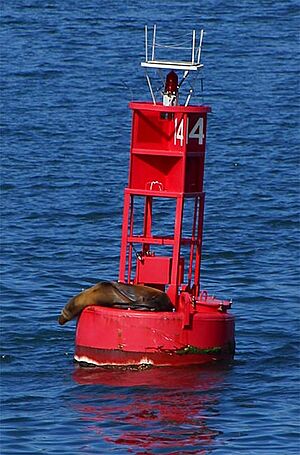
See also
 In Spanish: Boya para niños
In Spanish: Boya para niños


